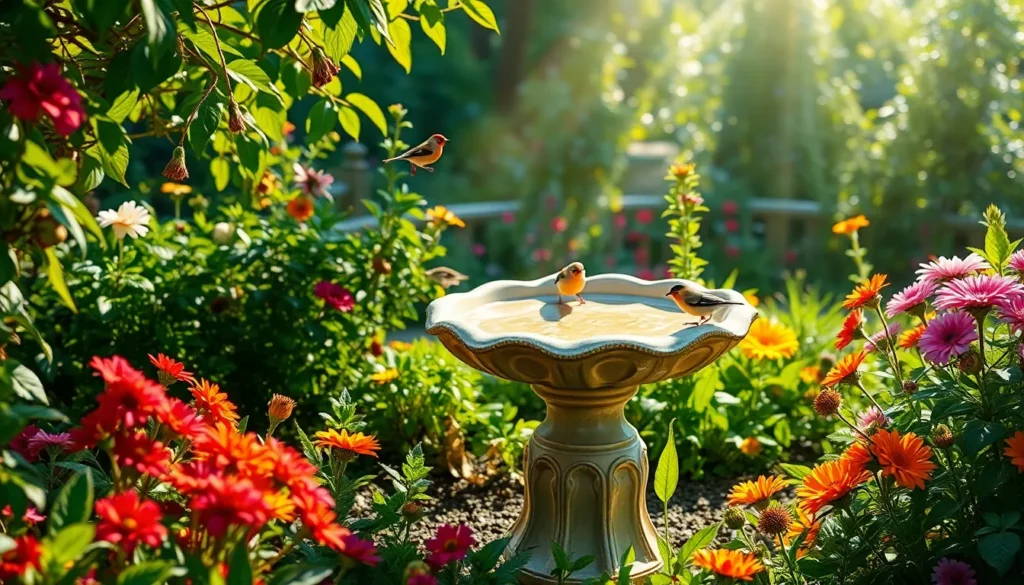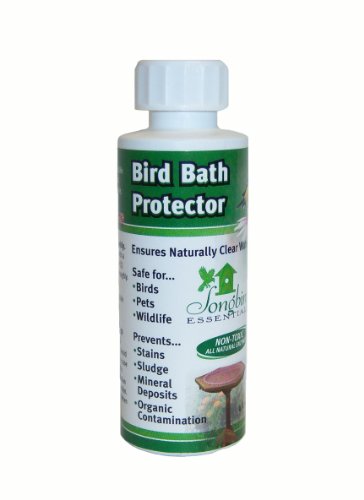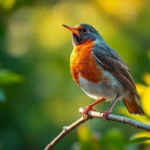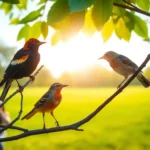We’ve all experienced that magical moment when birds gracefully visit our outdoor spaces. A well-placed bird bath transforms any yard into a thriving wildlife sanctuary that brings nature’s most beautiful creatures right to your doorstep. Whether you’re an experienced birder or simply love watching feathered friends splash and play these essential garden features create endless opportunities for backyard entertainment.
Bird baths aren’t just decorative elements – they’re vital water sources that support local bird populations while adding charm to your industry. From classic pedestal designs to modern ground-level basins there’s a perfect style for every garden aesthetic and budget.
Creating an inviting bird bath setup requires more than just filling a bowl with water. The right placement depth and maintenance routine can mean the difference between an empty basin and a bustling avian hub that attracts dozens of species throughout the seasons.
Choose the Right Bird Bath Material for Your Garden
Selecting the perfect material for your bird bath significantly impacts both its longevity and appeal to feathered visitors. We’ll explore the most popular options to help you make an well-informed choice that suits your garden’s needs and aesthetic preferences.
Ceramic and Stone Options
Ceramic bird baths offer exceptional beauty and come in countless decorative designs that complement any garden style. These glazed surfaces resist staining and clean easily with simple soap and water maintenance. We recommend ceramic options for gardeners who prioritize visual appeal and don’t mind occasional winter storage requirements.
Stone bird baths provide unmatched durability and natural integration with outdoor environments. Materials like granite, slate, and sandstone withstand extreme weather conditions while developing attractive patina over time. Natural stone surfaces give birds better grip when landing and drinking, though these heavier options require sturdy mounting or placement on level ground.
Concrete bird baths combine affordability with long-lasting performance in various climate conditions. These versatile pieces accept paint treatments and decorative additions while maintaining their structural integrity for decades. Rough concrete textures provide excellent footing for small songbirds, though we suggest sealing new concrete baths before first use.
Metal and Plastic Alternatives
Copper bird baths develop beautiful verdigris patinas that enhance garden aesthetics while naturally preventing algae growth through antimicrobial properties. These lightweight options move easily for seasonal placement changes and resist damage from freezing temperatures. Quality copper baths last for generations with minimal maintenance beyond occasional gentle cleaning.
Aluminum and steel bird baths offer modern styling at budget-friendly prices while providing excellent durability in harsh weather conditions. Powder-coated finishes prevent rust and corrosion while maintaining attractive appearances season after season. We suggest choosing darker colors to prevent water from becoming too hot during summer months.
Plastic bird baths deliver unbeatable affordability and portability for renters or budget-conscious gardeners seeking temporary answers. High-quality resin models mimic stone and ceramic appearances while weighing significantly less than natural alternatives. UV-resistant plastics prevent fading and cracking, though we recommend choosing thicker-walled options for better stability and longevity.
Natural Wood Considerations
Cedar bird baths provide natural water resistance and insect-repelling properties that make them ideal for organic gardening environments. These aromatic woods weather gracefully without chemical treatments while blending seamlessly into rustic and cottage garden designs. Regular oiling maintains cedar’s natural protective qualities and extends lifespan considerably.
Teak bird baths represent premium wood choices that withstand moisture exposure without rotting or warping over extended periods. Dense grain structures resist water penetration while natural oils repel insects and prevent decay. We recommend teak for permanent installations where initial investment costs justify decades of reliable performance.
Reclaimed wood bird baths offer eco-friendly alternatives that add character and sustainability to garden spaces while reducing environmental impact. Weathered barn wood and salvaged lumber create unique focal points with distinctive aging patterns and natural imperfections. Proper sealing protects reclaimed materials while preserving their rustic charm and historical character.
Position Your Bird Bath for Maximum Bird Activity
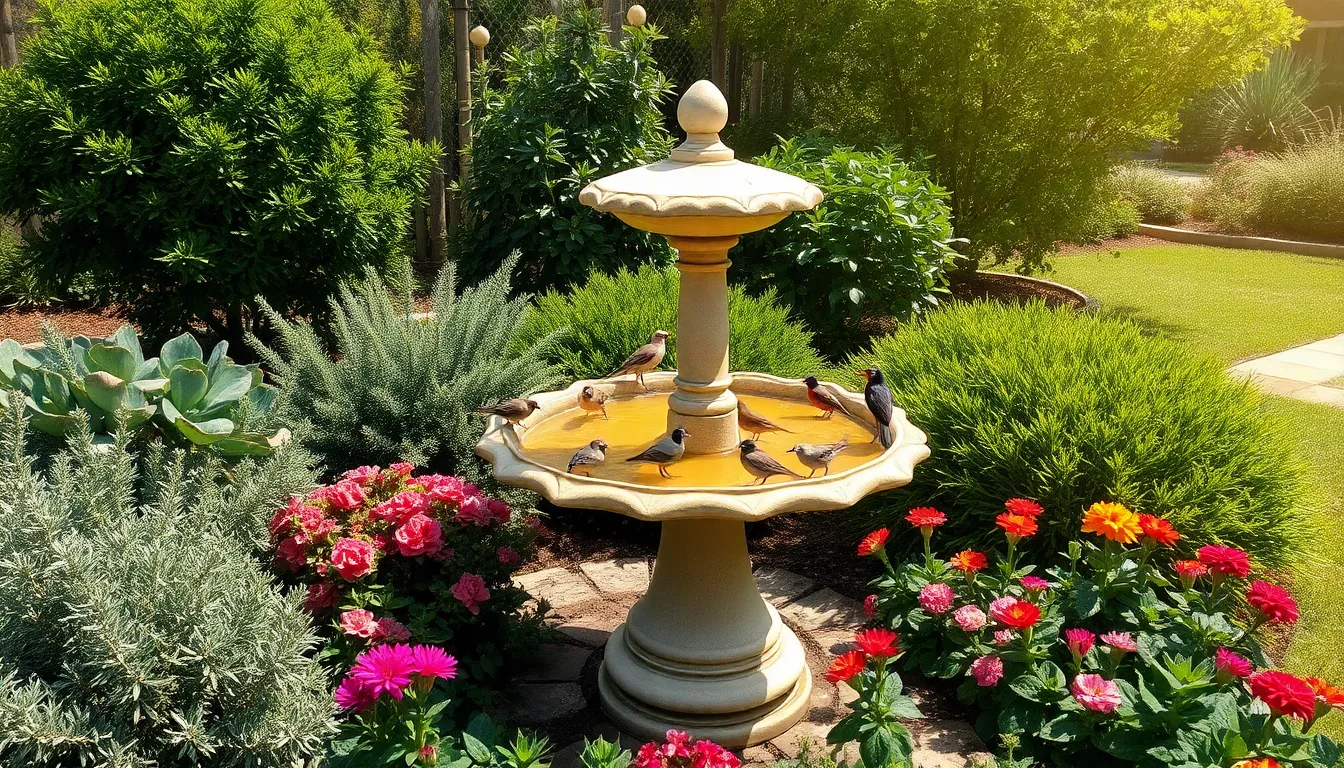
We’ve found that strategic positioning transforms an ordinary bird bath into a bustling hub of avian activity. The right location makes all the difference in attracting diverse bird species to our outdoor spaces.
Optimal Height Requirements
Height placement directly impacts which bird species we’ll attract to our water feature. Small songbirds like finches and chickadees prefer bird baths positioned 24 to 36 inches above ground level for easy access and safety.
Ground level bird baths work best for larger species such as robins, cardinals, and blue jays who feel more comfortable drinking from lower water sources. Elevated platforms at 3 to 5 feet attract different birds including mourning doves and woodpeckers who prefer higher vantage points.
Tiered systems offer multiple height options in a single installation. We recommend placing shallow basins at various levels to accommodate birds of all sizes simultaneously.
| Bird Type | Preferred Height | Examples |
|---|---|---|
| Small songbirds | 24-36 inches | Finches, chickadees, wrens |
| Medium ground birds | 12-24 inches | Robins, cardinals, thrushes |
| Large birds | Ground level | Blue jays, crows, doves |
| Tree dwellers | 3-5 feet | Woodpeckers, nuthatches |
Distance from Feeders and Shelter
Strategic spacing between bird baths and feeding areas prevents overcrowding while encouraging natural behavior patterns. We suggest placing water sources 10 to 15 feet away from seed feeders to create separate activity zones.
Shelter placement requires careful consideration for bird safety and comfort. Position bird baths within 3 to 10 feet of shrubs, trees, or dense vegetation where birds can quickly escape from predators.
Avoid placing water features directly under dense canopy cover where falling debris accumulates quickly. Open areas with nearby escape routes provide the perfect balance of visibility and security for visiting birds.
Multiple access points become essential when positioning near shelter. Create clear flight paths from several directions so birds don’t feel trapped while drinking or bathing.
Sun and Shade Balance
Morning sunlight exposure helps evaporate overnight moisture and prevents algae growth in our bird bath water. East facing positions receive gentle dawn light while avoiding harsh afternoon rays.
Partial shade during peak afternoon hours keeps water temperatures comfortable for birds and reduces rapid evaporation. We aim for 4 to 6 hours of morning sun followed by filtered afternoon shade.
Seasonal sun patterns affect bird bath placement throughout the year. Consider deciduous tree coverage that provides summer shade while allowing winter sunlight to reach the water surface.
Temperature regulation becomes crucial in extreme weather conditions. Full shade locations in hot climates prevent water from becoming uncomfortably warm, while sunny spots in cooler regions extend the bathing season for our feathered visitors.
Maintain Proper Water Depth and Fresh Water Supply
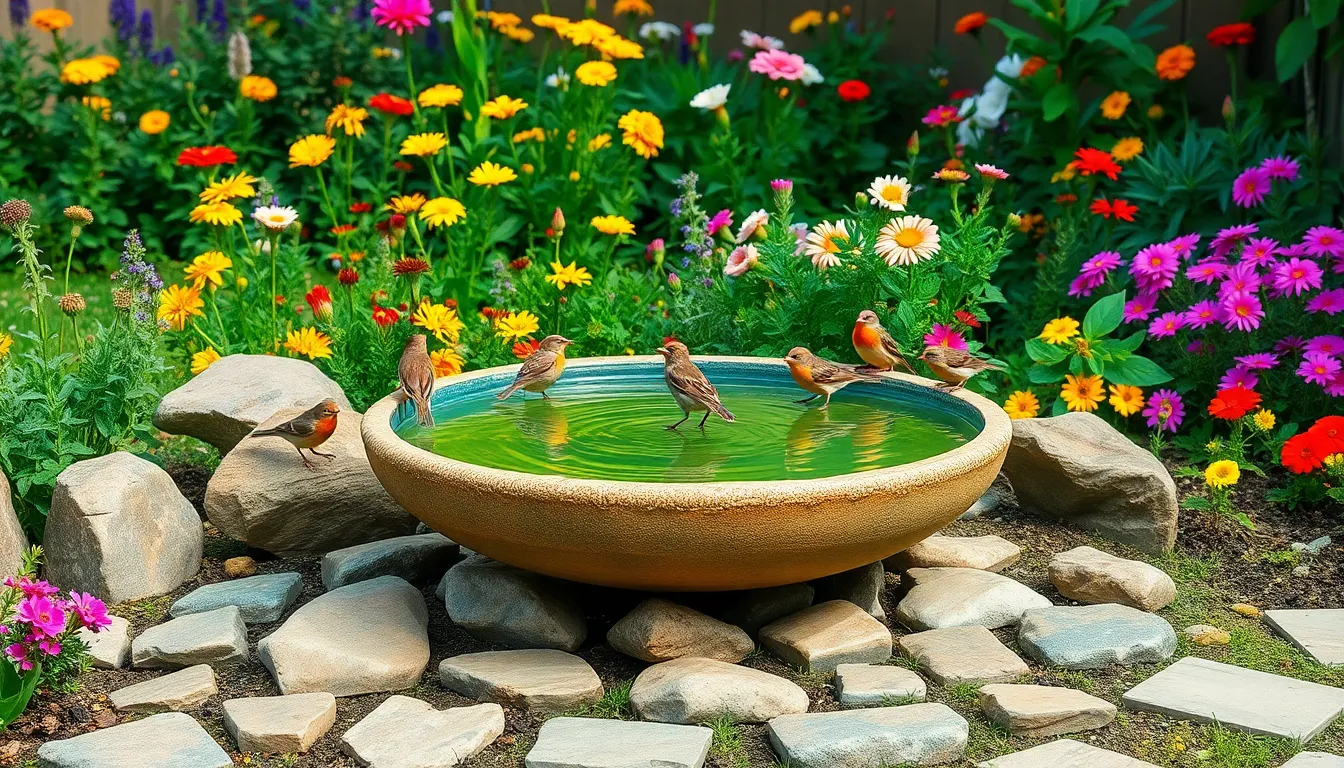
Water management forms the foundation of successful bird bath maintenance. Strategic depth control and consistent freshness ensure your feathered visitors return regularly while preventing health hazards that stagnant water creates.
Ideal Water Depth Guidelines
Different bird species require exact water depths for comfortable bathing and drinking. Small songbirds like finches, chickadees, and wrens prefer shallow areas measuring 0.5 to 1 inch deep where they can easily wade without fear of drowning. Medium sized birds such as robins, cardinals, and blue jays feel most secure in water depths ranging from 1 to 2 inches that allow proper bathing motions without overwhelming their bodies.
Create graduated depths throughout your bird bath to accommodate various species simultaneously. Place flat stones or decorative rocks along one edge to form shallow stepping areas while maintaining deeper sections in the center. This design approach attracts everything from tiny hummingbirds seeking quick sips to larger thrushes requiring full body immersion for effective bathing.
Monitor water levels consistently since evaporation reduces depth significantly during hot weather. Summer temperatures can lower water depth by half an inch daily in exposed locations, transforming suitable bathing areas into unusable shallow puddles. We recommend checking depth every morning and adding fresh water to maintain optimal levels for your regular bird visitors.
Frequency of Water Changes
Replace bird bath water every 2 to 3 days during moderate temperatures to prevent bacterial growth. Stagnant water develops harmful microorganisms within 72 hours that can cause serious illness in birds, making frequent changes essential for their health and safety. Hot summer conditions accelerate bacterial multiplication, requiring daily water replacement when temperatures exceed 80°F consistently.
Change water immediately after observing debris, droppings, or algae formation regardless of your regular schedule. Bird waste introduces dangerous pathogens that multiply rapidly in warm water, creating toxic conditions that can spread disease throughout your local bird population. Fallen leaves, seeds, and insects also decompose quickly, depleting oxygen levels and creating unsuitable drinking conditions.
Winter water changes happen less frequently but remain crucial for preventing ice formation and contamination. Cold temperatures slow bacterial growth but don’t eliminate the need for fresh water replacement every 4 to 5 days. We suggest using heated bird bath elements or replacing water with slightly warm liquid to prevent immediate freezing while maintaining safety for winter bird species.
Cleaning Schedule Recommendations
Scrub your bird bath thoroughly once weekly using a stiff brush and mild dish soap to remove algae buildup. Green algae growth creates slippery surfaces that make bathing dangerous for birds while also producing toxins that contaminate drinking water. Focus cleaning efforts on textured areas where algae typically accumulates, including decorative ridges and rough stone surfaces.
Disinfect bird baths monthly with a diluted bleach solution containing one part bleach to nine parts water. This cleaning ratio eliminates persistent bacteria and parasites without leaving harmful residues that could poison visiting birds. Rinse the basin completely multiple times after bleach treatment and allow it to air dry for 30 minutes before refilling with fresh water.
Seasonal deep cleaning involves removing mineral deposits and addressing weather related damage to maintain functionality. Spring cleaning removes winter debris and ice damage while preparing the basin for increased bird activity during nesting season. Fall maintenance includes removing fallen leaves and applying protective treatments to prevent cracking from freeze thaw cycles during colder months.
Attract Different Bird Species with Strategic Placement
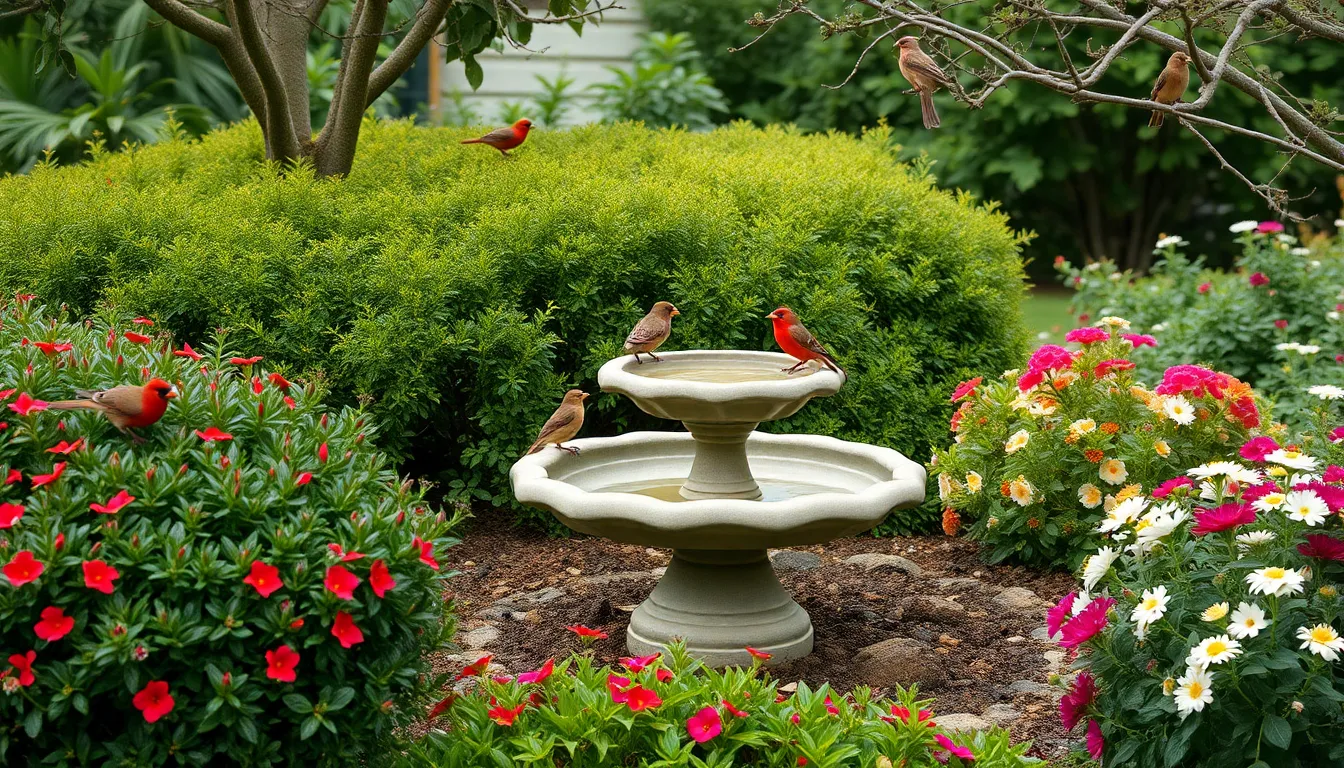
Strategic placement of bird baths significantly influences which bird species will visit our gardens. Different birds have unique preferences for bathing locations that align with their natural behaviors and safety needs.
Ground-Level vs. Elevated Options
Ground level bird baths attract larger bird species like robins, thrushes, and towhees that naturally forage on the ground. These birds feel comfortable accessing water at their typical feeding height and appreciate the stability of ground placement. Cardinals, blue jays, and mourning doves also prefer ground level options where they can approach cautiously and maintain awareness of their surroundings.
Elevated bird baths positioned 24 to 36 inches high appeal to smaller songbirds including finches, chickadees, and wrens. These species feel safer at higher elevations where they can quickly spot potential threats. Pedestal mounted baths work exceptionally well for attracting warblers, nuthatches, and titmice that spend most of their time in trees and shrubs.
Platform feeders combined with elevated baths create feeding stations that accommodate both feeding and bathing behaviors. Hummingbirds particularly enjoy shallow elevated baths where they can hover while bathing or perch on thin edges.
Near Natural Cover and Perching Spots
Positioning bird baths within 3 to 10 feet of dense shrubs provides essential escape routes for bathing birds. Evergreen shrubs like juniper, holly, and pine offer year round protection that birds rely on when they’re vulnerable during bathing. Deciduous bushes such as elderberry, serviceberry, and native roses create seasonal cover while providing food sources.
Overhanging tree branches serve as natural perches where birds can observe the area before approaching the water. Oak, maple, and dogwood trees offer sturdy branches at varying heights that accommodate different species’ perching preferences. Dead trees or snags provide additional perching spots that woodpeckers, flycatchers, and other cavity nesting birds frequently use.
Nearby flowering plants like bee balm, coneflower, and native grasses attract insects that birds consume before or after bathing. This creates a complete habitat zone that meets multiple needs within a concentrated area.
Multiple Bath Locations
Installing bird baths in different areas of our yard accommodates various species’ territorial preferences and reduces competition. Front yard placements attract different birds than backyard locations due to varying noise levels, human activity, and vegetation types.
Corner placements in garden beds create secluded bathing areas that appeal to shy species like wood thrushes and hermit thrushes. Open lawn areas with scattered baths work well for ground feeding birds like juncos and sparrows that prefer clear sightlines.
Creating bathing stations at different elevations throughout the property maximizes species diversity. We can position one ground level bath near berry bushes, one elevated bath near flowering trees, and one hanging bath near dense shrubs to create distinct habitat zones.
Seasonal rotation of multiple baths helps us identify which locations receive the most bird traffic throughout the year. Moving portable baths to sunnier spots during winter and shadier locations during summer optimizes water temperature and prevents freezing or overheating.
Keep Your Bird Bath Clean and Safe for Wildlife
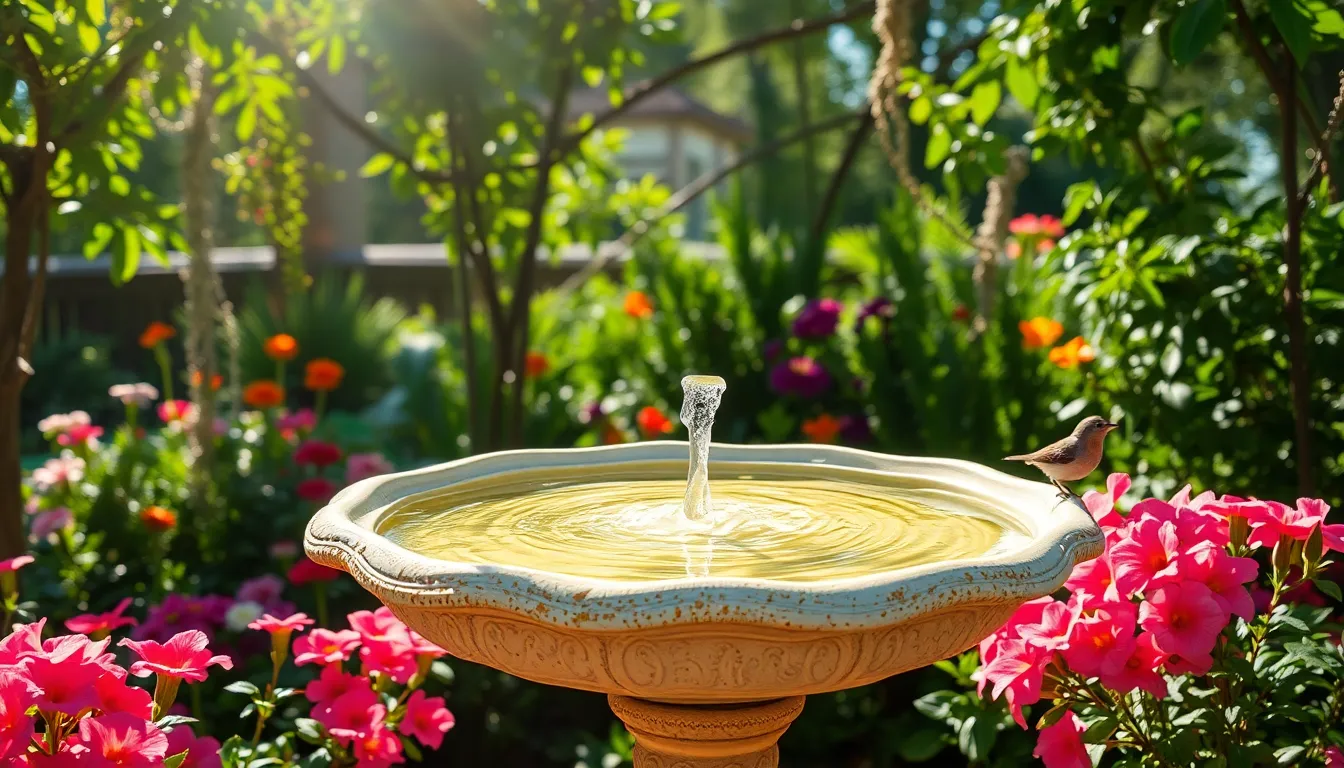
Maintaining a pristine bird bath environment protects visiting wildlife from harmful bacteria and parasites. Clean water sources ensure birds stay healthy while encouraging repeat visits to your outdoor space.
Regular Scrubbing Techniques
Scrub your bird bath every 2-3 days using a stiff brush to remove biofilm and debris buildup. Focus on the basin’s textured surfaces where bacteria typically accumulate, paying special attention to corners and decorative grooves.
Remove all water before beginning the cleaning process, then apply gentle pressure while scrubbing in circular motions. Use an old toothbrush to reach intricate design elements and tight spaces that harbor organic matter.
Rinse thoroughly after scrubbing to eliminate any loosened particles and cleaning residue. Hot weather conditions may require daily cleaning, especially when temperatures exceed 80°F and algae growth accelerates.
Check for cracks or chips during each cleaning session, as these imperfections can harbor dangerous bacteria that standard scrubbing cannot remove. Replace damaged basins immediately to maintain safe drinking conditions for wildlife.
Safe Cleaning Products to Use
White vinegar serves as the safest cleaning solution for bird baths, effectively killing bacteria without leaving toxic residues. Mix one part vinegar with nine parts water to create a gentle yet effective cleaning solution.
Baking soda works excellently for removing stubborn mineral deposits and algae stains from basin surfaces. Create a paste using equal parts baking soda and water, then scrub gently before rinsing completely.
Avoid bleach, soap, and commercial detergents entirely, as these chemicals can poison birds even in trace amounts. Never use antibacterial cleaners or disinfectants designed for human use around wildlife water sources.
Hydrogen peroxide offers another bird safe alternative for deep cleaning, using a 3% solution diluted with equal parts water. This combination eliminates harmful microorganisms without creating lasting chemical residues that endanger visiting birds.
Preventing Algae Growth
Position your bird bath in areas receiving partial shade during midday hours to reduce direct sunlight exposure. Full sun conditions promote rapid algae development, especially during summer months when temperatures remain consistently high.
Change water completely every 48 hours during warm weather to prevent algae spores from establishing colonies. Fresh water contains fewer nutrients that fuel algae growth, maintaining clearer conditions for drinking and bathing.
Add a small fountain or dripper to create gentle water movement that disrupts algae formation naturally. Moving water stays oxygenated and cooler, creating conditions that inhibit algae while attracting more bird species.
Install your bird bath away from fertilized lawn areas and garden beds where nutrient runoff encourages excessive algae blooms. Consider elevating the basin on a pedestal to minimize contact with ground level organic matter and debris.
Winterize Your Bird Bath for Year-Round Use
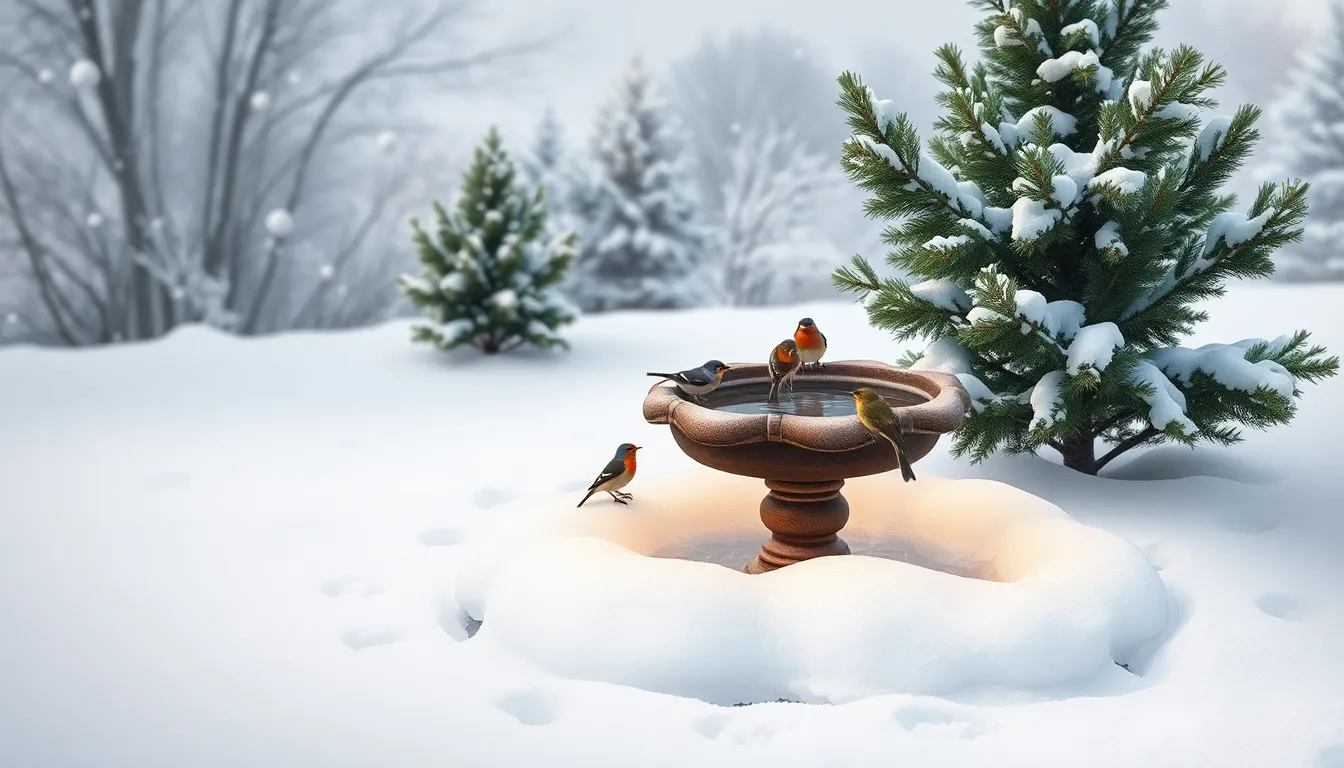
Cold weather shouldn’t stop birds from accessing the water they desperately need. We’ll help you transform your bird bath into a winter sanctuary that supports local wildlife through the harsh months.
Heated Bird Bath Options
Electric heated bird baths provide consistent water temperatures between 35°F and 45°F throughout winter months. These units feature built-in thermostats that automatically activate when temperatures drop below freezing, ensuring water remains accessible without wasting energy during warmer periods.
Heated base attachments convert existing bird baths into winter-friendly water sources for around $25 to $60. Models like the API Heated Bird Bath Base and K&H Thermo-Pond Perfect Climate Deluxe fit most standard bowl sizes and use only 150 watts of power.
Solar heated options operate without electricity costs while maintaining ice-free water during sunny winter days. Brands such as Smart Solar and Vintiquewise offer models with backup battery systems that store energy for cloudy periods, though they work best in regions with moderate winter temperatures.
Ceramic heated bowls resist cracking in freezing temperatures better than standard materials while providing built-in heating elements. Companies like Songbird Essentials manufacture bowls that withstand temperature fluctuations from -20°F to 120°F without damage.
De-Icing Answers
Floating de-icers keep water moving and prevent ice formation using minimal electricity consumption of just 50 to 100 watts. Products like the Farm Innovators Model P-418 create gentle water movement that discourages ice crystals from forming on the surface.
Immersion heaters warm water directly from within the bowl and automatically shut off when temperatures rise above 40°F. Safe models include the Allied Precision 7521 Floating Heater, which features a protective plastic housing that won’t harm birds who touch it while drinking.
Tennis ball tricks provide a simple non-electric solution by creating surface movement that delays ice formation. Dropping a standard tennis ball into the water creates gentle agitation from wind movement, though this method only works in temperatures slightly below freezing.
Glycerin additions lower water’s freezing point naturally without harming birds when used in proper concentrations. Mix one teaspoon of food-grade glycerin per gallon of water to prevent freezing down to approximately 25°F, but never use automotive antifreeze which is toxic to wildlife.
Cold Weather Maintenance
Daily water checks become essential during winter months when temperatures fluctuate rapidly between day and night. Remove ice formations each morning and refill with fresh lukewarm water to ensure birds have access throughout their most active feeding periods.
Insulation techniques help maintain warmer water temperatures using materials like foam padding around the base or wrapping heating elements in weatherproof covers. Place reflective materials beneath heated baths to redirect warmth upward and reduce energy consumption by up to 20%.
Strategic positioning takes advantage of natural windbreaks and southern exposure to maximize sun warmth during winter days. Move portable baths closer to heated buildings or install them near evergreen shrubs that provide protection from harsh winter winds.
Cleaning frequency increases to every 1-2 days during winter because birds concentrate their visits around fewer available water sources. Use warm water and white vinegar to remove ice residue and prevent bacterial buildup that thrives in stagnant winter conditions.
Enhance Your Bird Bath with Decorative Features
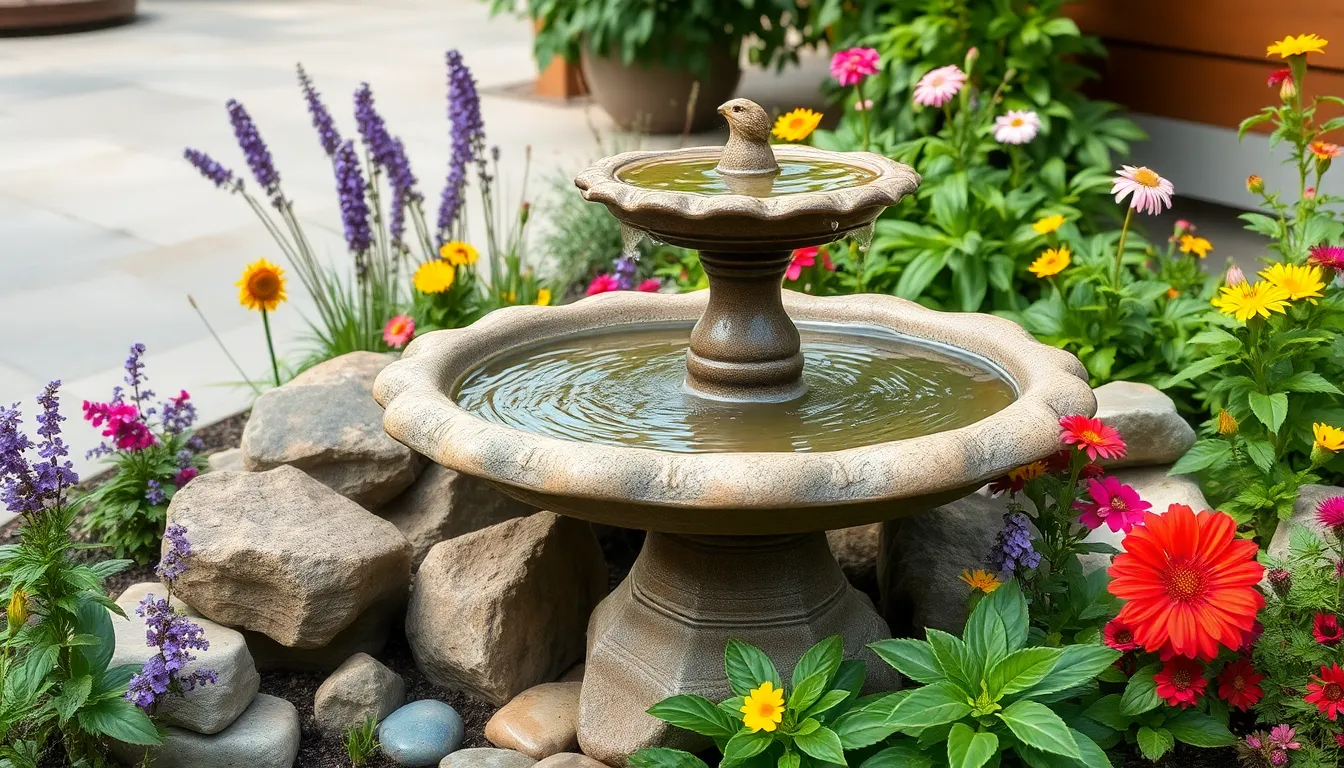
Transforming your bird bath from a simple water source into an eye-catching garden focal point creates visual appeal while attracting more diverse bird species. Strategic enhancements combine functionality with artistic elements to maximize both wildlife activity and aesthetic value in your outdoor space.
Fountain and Dripper Additions
Fountains create continuous water movement that prevents stagnation while producing gentle sounds that attract birds from greater distances. Solar-powered fountain pumps eliminate electrical costs and installation complexity by operating directly from sunlight during peak bird activity hours. Battery-operated pumps provide consistent water circulation even during cloudy weather conditions and typically run for 8-12 hours per charge cycle.
Dripper systems offer subtle water movement through controlled droplet release that creates ripple effects across the bath surface. Adjustable flow rates allow customization from 1-5 drops per minute to match different bird preferences and seasonal activity levels. Recirculating drippers conserve water by cycling the same supply through internal tubing systems while maintaining the attractive sound and movement that birds seek.
Bubbler attachments produce gentle water bubbling that aerates the bath while creating visual interest through surface disturbance patterns. Installation requires simple connection to standard bird bath pedestals without permanent modifications to existing structures. Timer-controlled features operate fountains and drippers during optimal bird visiting hours from dawn to dusk while conserving energy during inactive periods.
Surrounding Plant Choices
Native shrubs provide essential cover and perching spots within 3-6 feet of bird baths while offering natural food sources through berries and insects. Elderberry bushes, serviceberry trees, and native honeysuckle varieties create multi-level shelter that accommodates different bird species’ comfort zones. Dense foliage plants like juniper, holly, and evergreen varieties offer year-round protection and nesting opportunities near water sources.
Ground cover options including wild strawberry, creeping phlox, and native sedges create natural landing areas while reducing mud formation around bird bath bases. Low-growing plants prevent water contamination from soil runoff during rain events while maintaining easy access for ground-feeding birds like towhees and sparrows. Flowering perennials such as coneflowers, bee balm, and cardinal flower attract insects that serve as protein sources for visiting birds throughout the growing season.
Ornamental grasses like fountain grass, feather reed grass, and little bluestem provide seed heads that offer natural food supplies during fall and winter months. Strategic placement creates wind barriers that reduce water evaporation while adding texture and movement to the surrounding industry design. Herb gardens featuring lavender, rosemary, and native mint varieties deter harmful insects while attracting beneficial pollinators that birds consume as food sources.
Artistic Design Elements
Decorative stones transform plain bird bath edges into artistic focal points while providing textured perching surfaces for smaller songbirds. River rocks, colored glass pebbles, and polished granite chips create visual depth while improving grip for bird feet during bathing activities. Mosaic tiles applied to bath rims and bases add personalized color patterns that complement existing garden themes and architectural elements.
Sculptural accents including ceramic birds, metal dragonflies, and stone garden figures create visual interest without interfering with actual bird behavior patterns. Weather-resistant materials like glazed ceramics, powder-coated metals, and natural stone withstand outdoor conditions while maintaining their aesthetic appeal throughout seasonal changes. Wind chimes positioned near bird baths produce gentle sounds that mask household noises while creating a peaceful atmosphere that encourages extended bird visits.
Lighting features such as solar-powered spotlights and submersible LED systems illuminate bird baths during evening hours while creating dramatic shadow patterns on surrounding surfaces. Warm white lights attract insects that nocturnal birds consume while avoiding harsh brightness that might disturb wildlife behavior patterns. Decorative bases including carved pedestals, wrought iron stands, and stacked stone platforms elevate bird baths to optimal viewing heights while serving as garden art pieces that enhance overall industry design.
Troubleshoot Common Bird Bath Problems
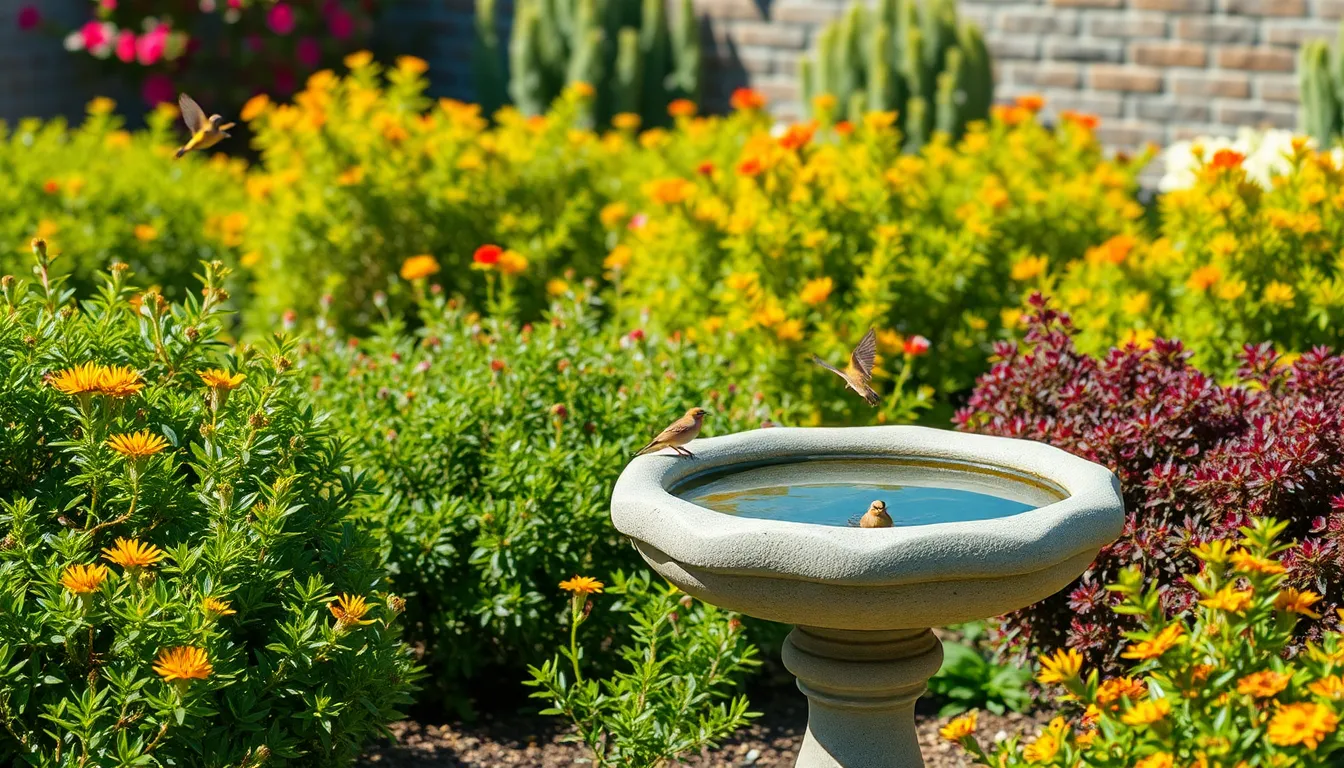
Even well-maintained bird baths can present challenges that require attention and adjustment. We’ll address the most common issues that prevent optimal bird bath performance.
Low Bird Visitation Issues
Location assessment reveals the primary cause of minimal bird activity around your water feature. Moving your bird bath closer to natural cover like shrubs or trees within 3 to 10 feet creates the safety corridor birds need for quick escapes.
Water depth adjustments solve accessibility problems for different bird species. Shallow areas measuring 1 to 2 inches accommodate smaller songbirds like finches and wrens, while deeper sections up to 4 inches attract larger birds such as robins and cardinals.
Visibility enhancement through strategic positioning attracts more avian visitors to your space. Placing bird baths in open areas where birds can easily spot potential predators increases their comfort level and encourages regular visits.
Competition reduction occurs when we install multiple bird baths throughout the yard. Territorial species like blue jays and mockingbirds won’t monopolize single water sources when alternatives exist within 15 to 20 feet of each other.
Seasonal timing affects bird bath usage patterns throughout the year. Spring migration periods from March through May and fall migrations from August through October typically show increased activity levels compared to summer breeding seasons.
Water Quality Concerns
Algae prevention requires consistent water replacement every 2 to 3 days during warm weather. Stagnant water develops green film within 48 hours in temperatures above 70°F, creating unsanitary conditions that deter bird visits.
Bacterial control starts with thorough cleaning using a 10% bleach solution weekly. Scrubbing all surfaces removes harmful pathogens like salmonella and E. coli that spread rapidly among bird populations sharing water sources.
Chemical contamination occurs when fertilizers, pesticides, or cleaning products enter bird bath water. Rinsing basins thoroughly after any nearby chemical applications protects birds from toxic exposure and potential poisoning.
Temperature regulation prevents water from becoming too hot or cold for bird use. Extreme temperatures above 85°F or below 35°F discourage drinking and bathing behaviors in most North American bird species.
Mineral buildup creates white residue on bird bath surfaces that affects water taste and quality. Using distilled water instead of tap water reduces calcium and lime deposits that accumulate over time.
Structural Maintenance Needs
Crack repair addresses common damage in ceramic and concrete bird baths caused by freeze-thaw cycles. Sealing hairline fractures with waterproof caulk prevents further deterioration and maintains structural integrity.
Stability improvement solves wobbling issues that frighten birds during use. Leveling uneven ground surfaces and securing pedestals with concrete footings creates the solid foundation birds require for safe bathing.
Surface restoration removes wear patterns and rough spots that develop over time. Sanding smooth any areas where birds’ claws have created grooves ensures comfortable perching around basin edges.
Hardware replacement maintains functionality in fountain and dripper systems attached to bird baths. Checking pumps, tubing, and electrical connections monthly prevents equipment failures that interrupt water circulation.
Weather protection extends bird bath lifespan through proper seasonal storage and covering. Bringing fragile materials like ceramic indoors during freezing temperatures prevents costly damage from expanding ice.
Conclusion
Creating a thriving bird-friendly environment through thoughtful bird bath selection and care transforms our outdoor spaces into vibrant wildlife sanctuaries. We’ve explored how the right materials placement and maintenance practices can attract diverse bird species while adding beauty to our gardens.
The key to success lies in understanding our feathered visitors’ needs and adapting our approach accordingly. Whether we choose ceramic stone or modern metal designs the principles remain the same: clean water proper depth and strategic positioning.
By implementing these strategies we’re not just installing a garden feature – we’re contributing to local wildlife conservation while enriching our daily outdoor experiences. The rewards of watching birds visit our carefully maintained baths make every effort worthwhile.
Frequently Asked Questions
What are the main benefits of having a bird bath in my yard?
Bird baths serve dual purposes as decorative garden elements and essential water sources for local bird populations. They attract various bird species, creating a lively wildlife sanctuary in your outdoor space. By providing clean water for drinking and bathing, bird baths enhance biodiversity while adding visual appeal to your garden landscape.
Which materials are best for bird baths?
Popular bird bath materials include ceramic (beautiful and easy to maintain), stone (durable and natural-looking), concrete (affordable and long-lasting), metal like copper or aluminum (modern styling), plastic (budget-friendly and portable), and natural woods like cedar or teak (aesthetically pleasing and water-resistant). Choose based on your budget, climate, and garden style.
Where should I place my bird bath for maximum bird activity?
Position bird baths near natural cover like dense shrubs or overhanging tree branches to provide escape routes and perching spots. Ground-level baths attract larger birds like robins, while elevated baths appeal to smaller songbirds. Install multiple baths in different yard areas to accommodate various species and reduce territorial competition.
How deep should the water be in a bird bath?
Water depth should vary to accommodate different bird species. Maintain 1-2 inches of water depth, with shallow areas for smaller birds and slightly deeper sections for larger ones. Consider adding stones or branches to create varying depths and provide safe perching spots for birds while they drink and bathe.
How often should I clean and change the water?
Change water every 2-3 days to prevent bacterial growth, more frequently during hot weather. Clean the basin weekly with a brush and mild soap, rinsing thoroughly. Monitor water levels daily, especially in summer. Regular cleaning prevents harmful bacteria and algae growth, ensuring a safe environment for visiting birds.
How can I keep my bird bath functional during winter?
Use heated bird baths or add de-icers to prevent freezing and provide accessible water during cold months. Position baths in sunny, sheltered locations to minimize ice formation. Clean regularly to remove debris and ensure heating elements function properly. Consider shallow water depths to prevent deep freezing.
What can I do if birds aren’t visiting my bird bath?
Check placement, water depth, and cleanliness. Move the bath closer to natural cover or food sources. Ensure water is fresh and 1-2 inches deep. Add water movement with drippers or fountains to attract attention. Install multiple baths to reduce competition, and be patient as birds need time to discover new water sources.
How can I enhance my bird bath’s appeal and functionality?
Add water movement features like fountains or drippers to attract birds through sound and motion. Surround with bird-friendly plants that provide cover and food sources. Include decorative elements like stones for perching and consider solar lighting for evening ambiance. Maintain multiple baths at different heights to accommodate various species.

